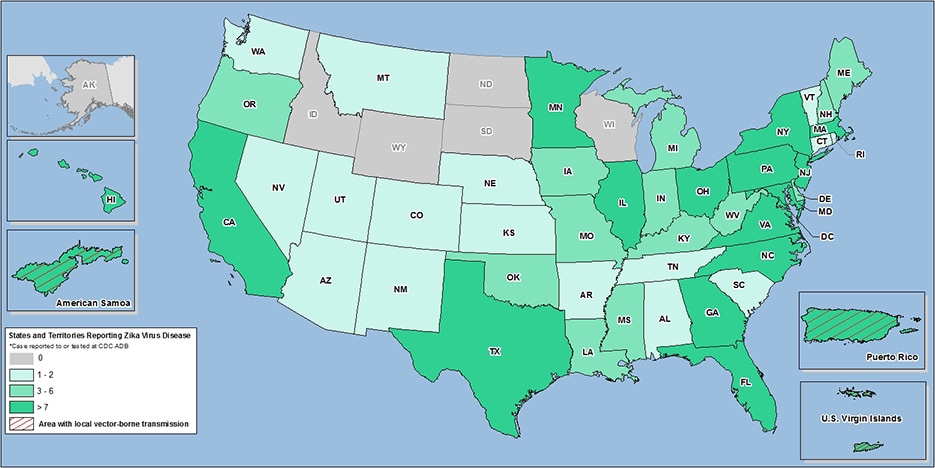WHO
Why is there particular focus on the current outbreak in Angola?
The ongoing outbreak of yellow fever in Angola (first reported in December 2015) is notable due to its urban nature. There has been extensive local transmission in Luanda, prompting the vaccination of more than 6 million people in the province since February this year. The epidemic has spread to several other major urban settings in the country.
Monitoring and prevention of international spread of the virus from Angola to neighbouring countries and beyond is also a key issue. Local transmission, linked to the epidemic in Angola, has been confirmed in the Democratic Republic of the Congo, while China and Kenya have recorded imported cases.
Yellow fever is endemic in Angola, but this is the first outbreak in 28 years. The last outbreak in the country occurred in 1988 with 37 cases and 14 deaths.
What is WHO doing to respond to the outbreak?
WHO and partners are working intensely to control the outbreak by supporting large-scale vaccination campaigns in both Angola and Democratic Republic of the Congo. More than 11 million doses of the yellow fever vaccine have been sent to Angola since February this year and more than 2 million to Democratic Republic of the Congo. The campaigns target provinces where local transmission has been confirmed and aims to immunize over 80% of the population in affected districts. Ensuring targeted vaccination makes best use of global vaccine supplies.
In addition to these mass vaccination campaigns, WHO is supporting the governments of Angola and Democratic Republic of the Congo to:
- Strengthen disease surveillance to ensure rapid detection and laboratory confirmation of suspect cases across the country;
- Implement vector control activities;
- Establish and reinforce community-led social mobilization activities.
What is WHO doing to prevent spread to neighbouring countries and beyond?
WHO is working with neighbouring countries, such as Namibia, Democratic Republic of the Congo and Zambia to bolster cross border surveillance with Angola to reduce the spread of infection across borders. The Organization supports the strengthening of vector control measures, including through public health education campaigns and larvae control.
WHO has reminded all countries of the need to enforce yellow fever vaccination requirements for travellers to and from Angola to prevent further spread of the disease. The Organization is also urging travellers to areas with yellow fever to ensure they are vaccinated and carry a certificate.
Is there a shortage of yellow fever vaccine?
Global supply of yellow fever vaccine is limited and its use needs to be prioritized and targeted to reach those populations at greatest risk. The International Coordinating Mechanism (ICG) for yellow fever, of which WHO is a key member, manages the global yellow fever vaccine stockpile and controls its supply to countries. In the light of the current outbreak, shipments of vaccines ordinarily used in routine immunization programmes in other endemic countries have been temporarily prioritized for use in Angola and other affected countries. WHO and partners are also working with pre-qualified manufacturers to increase global vaccine production.
Given the current limited supply of vaccine, WHO is exploring how best to maximize the use of available doses. This includes examining the feasibility of diluting or providing fractional doses of the vaccine. Approved yellow fever vaccines have higher potency than the minimum required to give immunity, and clinical studies have shown that using the doses more sparingly may be an option. Experts are exploring both the feasibility of this option, and the circumstances in which it could be used.
Is the current outbreak in Uganda linked to Angola?
In March this year, Uganda gave official notification of an outbreak of yellow fever. The outbreak is not linked to the Angola outbreak. Results of sequencing indicate strong similarities to the virus which caused a yellow fever outbreak in Uganda in 2010.
Has the pattern of yellow fever in Africa changed?
In 2006, the ‘Yellow Fever Initiative’ was launched. Led by WHO, and supported by UNICEF and national governments, the Initiative has made significant progress in West Africa to bring the disease under control. More than 105 million people have been vaccinated since its launch, and no yellow fever outbreaks have been reported in West Africa in 2015 or 2016.
However, since 2010, the location of yellow fever has shifted from West Africa to central and east Africa where no preventive mass vaccination campaigns have been conducted. The outbreak in Angola emphasizes the need to strengthen risk assessment and mass vaccination in central and east Africa.
The Yellow Fever Initiative, which focuses on highly endemic countries in Africa where the disease is most prominent, recommends including yellow fever vaccines in routine infant immunizations (starting at 9 months of age), implementing mass vaccination campaigns in high-risk areas for all people aged 9 months and older, and maintaining surveillance and outbreak response capacity.
Between 2007 and 2016, 14 countries have completed preventive yellow fever vaccination campaigns: Benin, Burkina Faso, Cameroon, Central African Republic, Côte d’Ivoire, Ghana, Guinea, Liberia, Mali, Senegal, Sierra Leone and Togo. Nigeria and Sudan have been implementing the campaigns. The Yellow Fever Initiative is financially supported by Gavi the Vacinne Allianace, the European Community Humanitarian Office (ECHO), the Central Emergency Response Fund (CERF), Ministries of Health, and the country-level partners.






